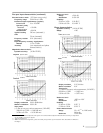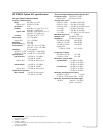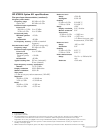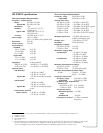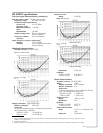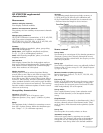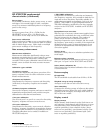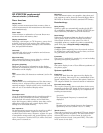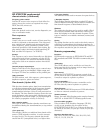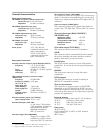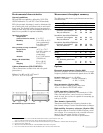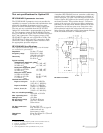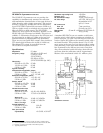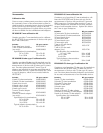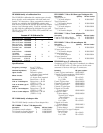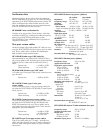
19
HP 8753ET/ES supplemental
characteristics (continued)
Frequency offset on/off
Sets the RF source to be swept at a fixed offset fre-
quency above the receiver as required in a swept
RF/IF, fixed LO, mixer test.
Service menu
Select the desired service test, service diagnostic, ser-
vice or verification mode.
Test sequences
Description
Create, edit, save or recall a series of front-panel key-
strokes to automate a measurement. Test sequences
may contain basic stimulus and measurement func-
tions (frequency, power, parameter, format, scale)
advanced operations (time domain, limit testing, dis-
play marker values) and basic logical branching (IF
limit test fails DO sequence 5 or GOSUB).
Storage
Test sequences can be stored internally to a disk drive
and can be loaded from a computer over the GP-IB
interface. Sequence 6 is saved in nonvolatile storage
and can be used as an autostart routine when titled
AUTO.
General purpose input/output
Read or write bits to the output port to control exter-
nal devices such as part handlers. Eight output and
five input TTL lines are available on the parallel port.
Other functions
PAUSE/continue, wait, title sequence, print sequence,
duplicate sequence, pause and select.
Time-domain (Option 010)
With the time-domain option, data from transmission
or reflection measurements in the frequency domain
are converted to the time domain using a Fourier
transformation technique (chirp Z) and presented on
the display. The time-domain response shows the mea-
sured parameter value versus time. Markers may also
be displayed in electrical length (or physical length if
the relative propagation velocity is entered).
Time stimulus modes
Two types of time excitation stimulus waveforms can
be simulated during the transformations, a step and an
impulse.
• Low-pass step
This stimulus, similar to a traditional time-domain reflec-
tometer (TDR) stimulus waveform, is used to measure
low-pass devices. The frequency-domain data should
extend from DC (extrapolated value) to a higher value.
• Low-pass impulse
This stimulus is also used to measure low-pass devices.
• Bandpass impulse
The bandpass impulse stimulates a pulsed RF signal
(with an impulse envelope) and is used to measure the
time-domain response of band-limited devices.
Windows
The windowing function can be used to modify (filter)
the frequency-domain data and thereby reduce over-
shoot and ringing in the time-domain response. Three
types of windows are available: minimum, normal, and
maximum.
Gating
The gating function can be used to selectively remove
reflection or transmission time-domain responses. In
converting back to the frequency-domain the effects of
the responses outside the gate are removed.
Remote programming
Interface
HP-IB interface operates to IEEE 488-1978 and IEC
625 standards and IEEE 728-1982 recommended prac-
tices.
Addressing
The GP-IB address can be verified or set from the
front panel via the local menu and can range from 0 to
30 decimal (factory set at 16).
Pass control
Allows the HP 8753ET/ES to request control of the
GP-IB (when an active controller is present) whenever
it needs to output to a plotter or printer.
System controller
Lets an HP 8753ET/ES become a controller on the
GP-IB to directly control a plotter or a printer.
Talker/listener
Lets the HP 8753ET/ES become an GP-IB talker/listen-
er when an external controller is present.
Transfer formats
Binary (internal 48-bit floating-point complex format)
ASCII 32- or 64-bit IEEE 754 floating-point format
User-accessible graphics
Using a subset of HP Graphics Language (HP-GL),
vector or text graphics may be written on the
HP 8753ET/ES via GP-IB. Up to 5 kbytes of data can
be stored at one time (4 bytes per vector, 2 bytes per
character).
Interface function codes
SH1, AH1, T6, TE0, L4, LE0, SR1, RL1, PP0, DC1,
DT0, C1, C2, C3, C10, E2



